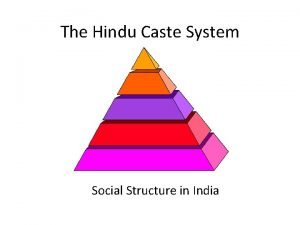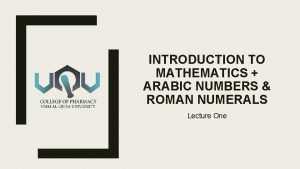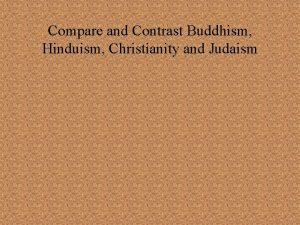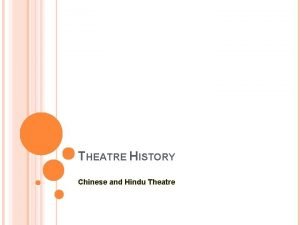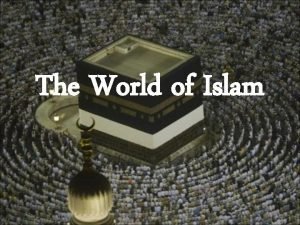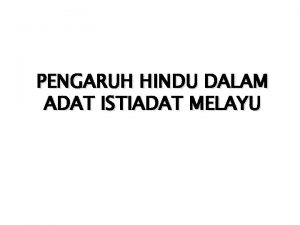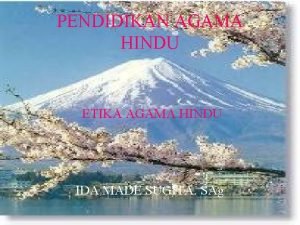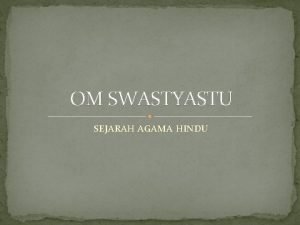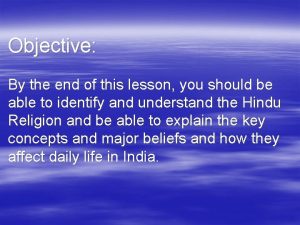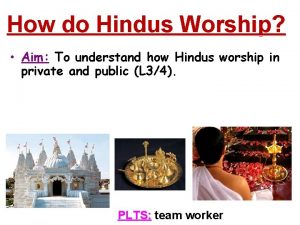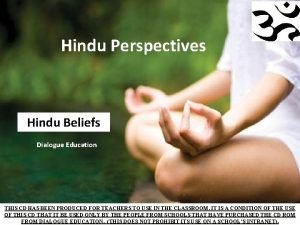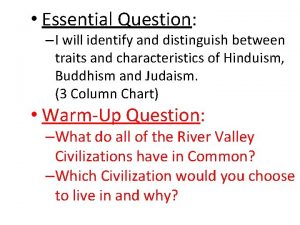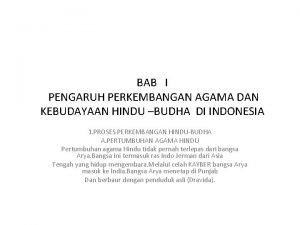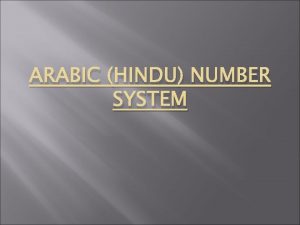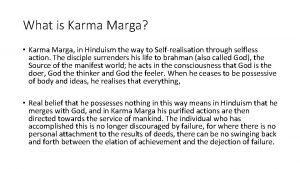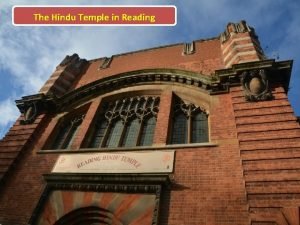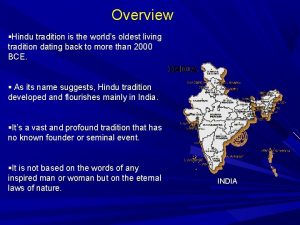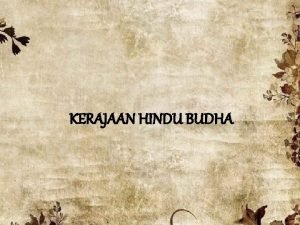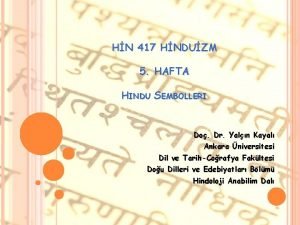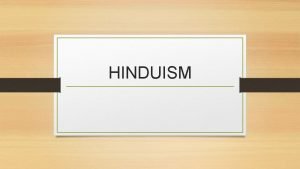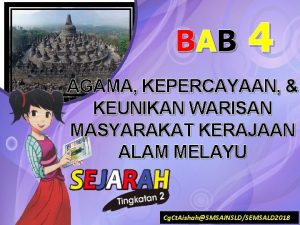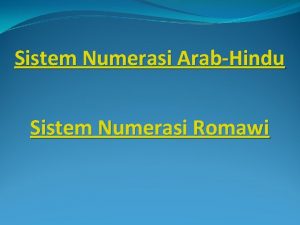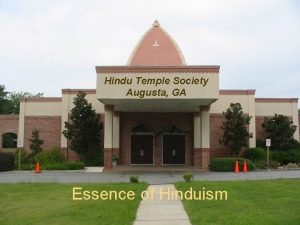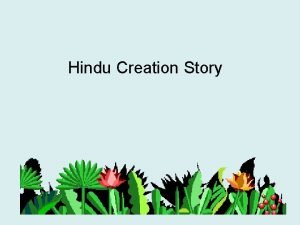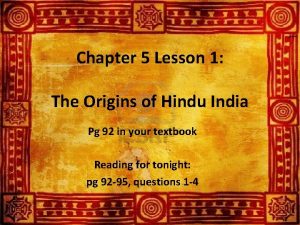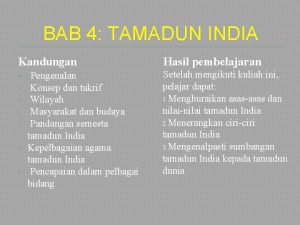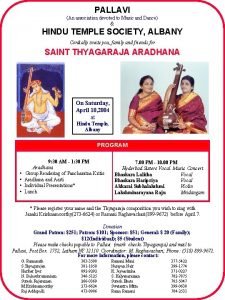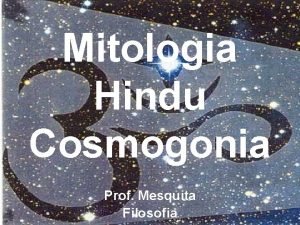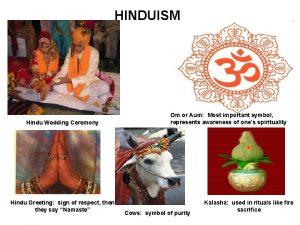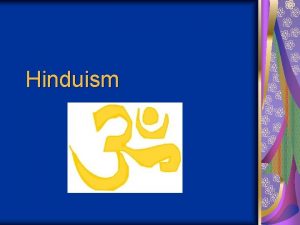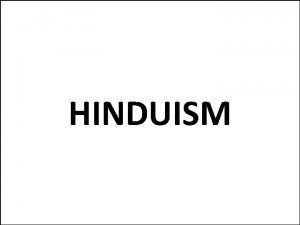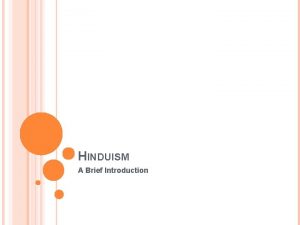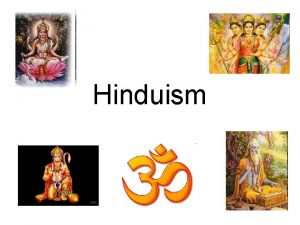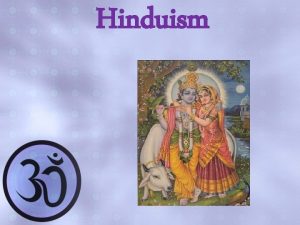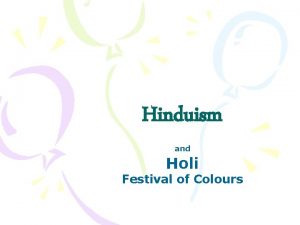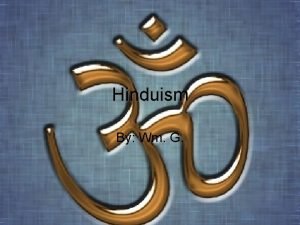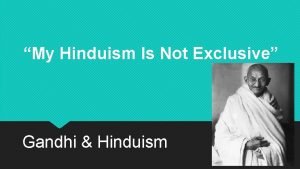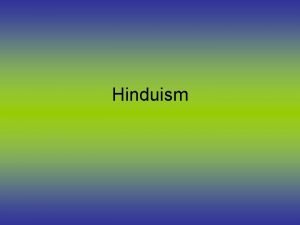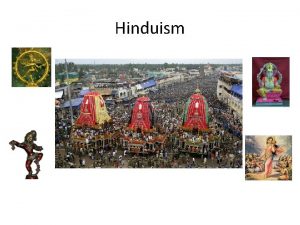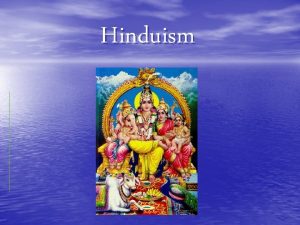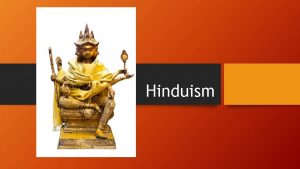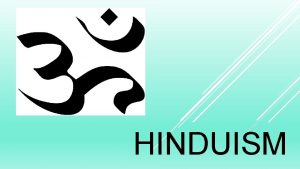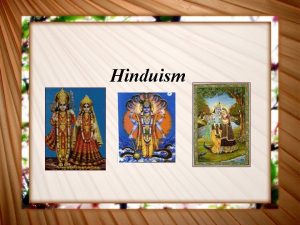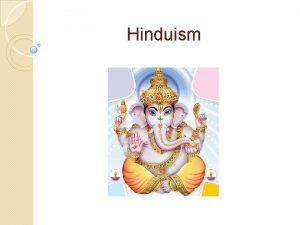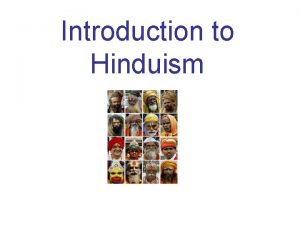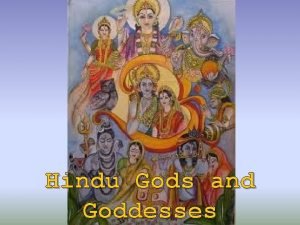Hinduism An Introduction What is Hindu Description and




































- Slides: 36

Hinduism An Introduction

What is Hindu? Description and Location(s)

What is “Hindu”? • Historically used as a geographical, cultural or religious identifier for people indigenous to the Indian subcontinent o Greek references in 1 st century BCE: Around or beyond the Sindhu (Indus) River

Hindu Identity • 13 th-18 th centuries: a sense of Hindu identity and the term Hindu appears in texts in Sanskrit and regional languages • 16 th century: those in India who are not Turks or Muslims • Currently: anyone who regards himself or herself as culturally, ethnically or religiously adhering to aspects of Hinduism


Hindu Populations • Third largest religious group at 1. 03 billion • Majority live in India: 966 million (2011 census) • Next 9 countries with the largest Hindu populations: o Nepal, Bangladesh, Indonesia, Pakistan, Sri Lanka, United States, Malaysia, United Kingdom and Myanmar

Origins of Hinduism Brief History

Origins • No particular founder • Absorbed ideas and practices that suited social/cultural framework over thousands of years

Origins - Indus River Valley Civilization • 2500 BCE - Indus River Valley Civilization

Origins - Indus River Valley Civilization • Advanced plumbing, architecture, populations of 40, 000+ • Advanced zoning o Civic center, residential areas • Drainage and sewer systems on 1 st and 2 nd floors of homes

Origins - Indus River Valley Civilization • Religious Evidence o Worship houses with stone sculptures • Early depictions of goddesses Parvati and Kali o Amulets to protect against evil, flat seals • Early representation of Shiva o Fire altars and pits with animal bones • Fire rituals and animal sacrifices

Crash Course Video

Origins - Aryans • 2000 -1500 BCE - Aryans enter from Central Asia/Europe • Spoke early form of Sanskrit • Created poems, rituals, philosophies

Vedas • Vedas – authoritative scripture to Hindus o Hymns, ritual texts, philosophy o Rig-Veda • Earliest record of sacred knowledge on Hinduism • Vedas = verse • Brahmanas = prose • Upanishads = mystical texts on the human existence

Aryan Religion • Worshipped forces of nature in the forms of deities o Agni: fire • Link between gods and humans • Core of early Hindu practice formed by worship and prayer rituals to honour and please deities • Upanishads combined prayer with philosophy about the human soul (atman)

Origins – Vedic Tradition • 1500 -500 BCE - Vedic Tradition develops into Hinduism o Dominated by priestly class who worshipped Agni (fire) o Rituals and many gods (polytheism) o Social stratification (caste system)

Hindu Beliefs Concept of God and Key Deities

Hindu Beliefs • Non-dogmatic religion o Free to worship any set of doctrines/rules o No conversion • Dharma o Code of moral and righteous duty o Vast body of rules and rituals for every stage of life • Complex web of diverse beliefs and practices held together by tolerance and respect

Fundamental Hinduism 1. Hindus believe in the existence of a supreme all-pervasive Being, who is both immanent and transcendent, both Creator and Unmanifest Reality. 2. Hindus accept the Vedas as the absolute scriptural authority. 3. Hindus believe in a code of ethics based on 4 pillars of righteous living as defined in Shrīmad Bhāgavatam: austerity (tapaḥ), purity (shaucham), compassion (dayā), and truthfulness (satyam). 4. Hindus believe in a prescribed method of living, with regard to its objectives, stages and milestones of life. 5. Hindus believe in specific tenets such as the law of cause and effect (karma), theory of reincarnation (punarjanma), and the incarnation of the supreme Lord into the world (avatāra). 6. Hindus have prescribed methods of offering worship to the Lord.

Hindu Concept of God • Brahma - One impersonal Ultimate Reality o Soul of the universe from which all existing things arise and into which they all return o Manifest as many personal deities • God can be thought of as Creator (Brahma), Preserver (Vishnu), and Destroyer (Shiva) • God is transpersonal: beyond it all o Brahma is everything and everywhere

Atman • True essence of life – Atman, the soul, is Brahma trapped in matter o tat twam asi = “you [atman] are that [Brahma]” – atman and Brahma are inseparable

Hindu Pantheon • Hinduism is highly polytheistic o Brahman as “ultimate reality”

Hindu Pantheon • The Hindu Pantheon is structured around “divine couples” who serve different functions in the universe o Male-structure/form & female-energy/matter • Many deities are depicted with a “vehicle” o Animal with whom they are often portrayed • The Hindu Trinity is organized around Brahma, Vishnu, and Shiva

Brahma • Creator of the universe • Four faces, seated on lotus • Holds a book, a rosary, and a gourd • Vehicle: peacock, swan, goose • Consort: Saraswati (knowledge and speech) o Depicted holding a book and veena (instrument)

Vishnu • Preserver of the universe o Loving and forgiving o Brings salvation • Four arms to hold shell, discuss, lotus, and mace • Vehicle: eagle • Many avatars (incarnation) o Appears on earth in animal or human form to conquer evil and establish righteousness o The two most important avatars of Vishnu are Rama and Krishna • Consort: Lakshmi (good fortune and prosperity) o Vehicle: “Garuda”—eagle/human hybrid

Shiva • Destroyer and restorer of the universe • A great yogi (spiritually evolved individual) • Holds a trident, rosary, and gourd • Vehicle: bull • Depicted as Nataraj – god of dance o Holding drum, serpent, sacred fire while performing dance of creation o Holds water from sacred Ganges in his hair • Consort: Parvati (mother goddess, female energy) o Durga – warrior goddess (riding tiger and holding many weapons) o Kali – fierce destroyer of evil

Ganesha • Son of Shiva and Parvati • Human body and elephant head with one short tusk o Other tusk used to write scriptures • Remover of all obstacles • Vehicle: mouse

A Hindu’s Life Impact of Belief on Everyday Living

Reincarnation • The soul does not die with the body but enters another body to carry on existing • Samsara o Endless cycle of rebirth – atman is continually born into this world lifetime after lifetime • Moksha o Ultimate goal of life – to release Atman and reunite with the divine, becoming as one with Brahman

Karma • Karma – all of one’s actions in life o Determines form at rebirth o Bad karma = rebirth at a lower station in life or lower form of life (animal) o Good karma = rebirth at higher station, closer to salvation • Lotus – symbol of karma o A blooming lotus simultaneously carries seeds inside itself while it blooms. • Seed is symbolically seen as cause, the flower effect o A reminder that one can grow, share good karma and remain unstained even in muddy circumstances

Caste System • Dates back to Vedic period • Born into each varna according to accumulated karma in previous lives

BBC – Intro to India’s Caste System

Paths to Salvation • Each of the 4 paths can lead to salvation if the follower is sincere

Paths to Salvation • Bhakti Yoga (Path of Devotion) o Devotion and love to personal deity o Worship Brahman in concrete way o Surrender to deity and delight in hearing and singing praises to him/her • Karma Yoga (Path of Action) o Good deeds and thoughts = good karma o Unselfish actions not for reward but due to morality and duty • Jnana Yoga (Path of Wisdom) o Guidance of a guru to learn scriptures, meditate, follow teachings to achieve salvation • Raja Yoga (Path of Meditation) o Salvation through meditation on Brahman o Intense meditation leads to trance-like state to acquire Truth and become one with Brahman o Strict physical and spiritual discipline

Four Stages of Life Stage (25 years) Student Householder Forest Dweller Ascetic Responsibilities

Four Aims of Life Aim Dharma Artha Kama Moksha Description
 Caste system india
Caste system india Hindu-arabic numbers
Hindu-arabic numbers Buddhism vs christianity
Buddhism vs christianity Compare and contrast hinduism and buddhism
Compare and contrast hinduism and buddhism 489 in roman numerals
489 in roman numerals Hindu theatre
Hindu theatre Hindu vs islam
Hindu vs islam Adat hindu
Adat hindu Etika agama hindu
Etika agama hindu Tri kang sinangguh guru
Tri kang sinangguh guru Hindu reincarnation chart
Hindu reincarnation chart Literatura antigua origen
Literatura antigua origen Labeled puja tray diagram
Labeled puja tray diagram Hindu temple of arizona
Hindu temple of arizona Hindu beliefs
Hindu beliefs Which cultures believe in reincarnation
Which cultures believe in reincarnation Obstructed heritage and unobstructed heritage
Obstructed heritage and unobstructed heritage Pengaruh dari perkembangan agama dan kebudayaan
Pengaruh dari perkembangan agama dan kebudayaan Origin of number system
Origin of number system Bhakti marga hinduism
Bhakti marga hinduism The hindu
The hindu Pedagang penguasa dan pujangga pada masa klasik hindu budha
Pedagang penguasa dan pujangga pada masa klasik hindu budha Varnashrama system
Varnashrama system Wilayah kekuasaan kutai
Wilayah kekuasaan kutai Caynizm sembolü
Caynizm sembolü Hindu triumvirate
Hindu triumvirate Hindu philosophy of education
Hindu philosophy of education Artificial person
Artificial person Keunikan warisan masyarakat kerajaan alam melayu
Keunikan warisan masyarakat kerajaan alam melayu Kelebihan sistem numerasi romawi
Kelebihan sistem numerasi romawi Hindu temple augusta ga
Hindu temple augusta ga Nonearth cup
Nonearth cup Chapter 5 lesson 1 origins of hindu india
Chapter 5 lesson 1 origins of hindu india Kesimpulan tamadun india
Kesimpulan tamadun india Citrus hindu mite
Citrus hindu mite Bhaskara haripriya
Bhaskara haripriya Brahman hindu
Brahman hindu
